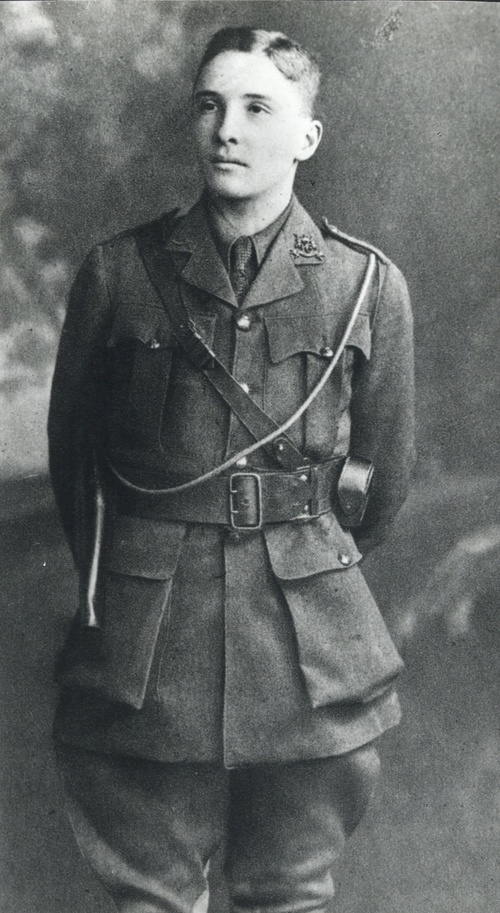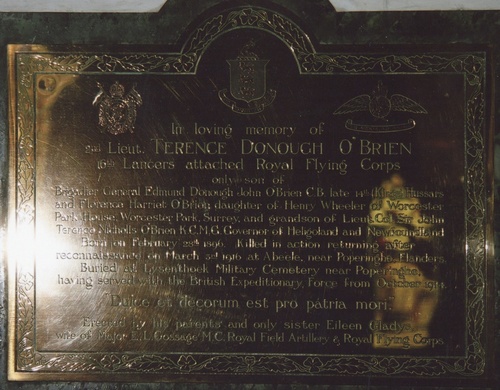Auction: 19003 - Orders, Decorations and Medals
Lot: 200
An extremely fine Royal Flying Corps Observer casualty campaign group of four awarded to 2nd Lieutenant T. D. O'Brien, 16th Lancers, attached Royal Flying Corps, who survived the 'bleakest day' of his Battalion at Zillebeke in February 1915 when he assumed command of a Squadron
Having joined the Royal Flying Corps and endured six months of scrapes in the skies above the Western Front, he was to be killed following a crash-landing near Ypres after yet another aerial sortie in March 1916, just days after having celebrated his 20th birthday
1914 Star, copy clasp (2. Lieut. T. D. O'Brien. 16/Lrs.); British War and Victory Medals (2. Lieut. T. D. O'Brien.), together with his Great War Bronze Memorial Plaque (Terence Donough O'Brien), housed within a superb contemporary leather fitted case, extremely fine (4)
Terence Donough O'Brien was born on 28 February 1896 at Ranikhet, India, the son of Brigadier General Edmund Donough John O'Brien, C.B., C.B.E., 14th Hussars, and his wife Florence, of Cupar, Fife, later Buxted Rectory, Sussex. Educated at St. Peter's Court School, Broadstairs, 1907-1909 and Winchester College, 1909-1913, he won a place at Jesus College, Cambridge, but left soon thereafter to go to Sandhurst. Commissioned 2nd Lieutenant in the 16th Lancers on 14 August 1914, he proceeded to join his Regiment in Flanders on 23 October 1914 and was present in the action of 21 February 1915 in the trenches just north of Klein Zillebeke on the edge of a wood known as Shrewsbury Forest, only a matter of 10 metres from the enemy lines (At the Going Down of the Sun - 365 Soldiers from the Great War, refers). It was here that the Lancers suffered the bleakest day in the history of their war, an extract from the War Diary describing those events:
'It had been suspected for some days that the enemy was running sap at the bottom of the ditch and a close observation had been kept on it, but no sign of anything of the sort had been discovered. It turned out afterwards that the enemy had really dug a sap half way down it, but had turned off at a sharp angle and continued the tunnel underground until it ran under the centre of the trench of 'D' Squadron, and that three mines had been placed at the end of it. It was afterwards ascertained from prisoners that the mines had been laid some days before the 16th had taken over the trenches, but that the explosion had been delayed with the intention of catching the relief when they were taking over on the 18th, but the opportunity had been missed.
At 6.00 a.m. on the 21st one mine was fired, followed immediately afterwards by the other two, with the result that the trench was completely destroyed. The enemy followed this up with a strong attack on the trenches on each side of that held by 'D' Squadron. There was of course much confusion and a hand to hand combat, in which the enemy was finally driven back by 'A' Squadron and the reserve troop of 'D' with a machine gun.'
Three hours later the line was reinforced by a Squadron of the 20th Hussars and a company of French Infantry, who were stopped at once by heavy German fire - all their officers and half their men being shot down in a few minutes. The 20th advanced a short distance but were halted by enfilade fire and were forced to break off the attack. No further attempt was made to regain the lost trench, a new one being dug that night to the rear of it. When the roll was called, the detonation of the mines and subsequent sudden assault had cost the lives of 5 officers and 7 men from the 16th Lancers, with a further officer and 29 men wounded. In addition, Lieutenant Ryan and 11 men were missing, likely buried by the detonation or captured and marched eastwards. As a result of such heavy losses, O'Brien was forced to take charge of his Squadron (Winchester College at War, refers).
In September 1915, O'Brien transferred to the Royal Flying Corps as an Observer and was posted to No. 6 Squadron. The Squadron had been formed at Farnborough on 31 January 1914 and specialised in photographic reconnaissance and artillery co-operation which largely involved spotting and ranging for the Batteries below. Operating in mostly misty and windy flying conditions above the Western Front, No. 6 Squadron were almost constantly in the air during daylight hours flying F.E.2b and B.E.2c machines. The work was gruelling and hazardous, heightened by the superiority at that time of the monoplane Fokker Eindecker and the vulnerability of the unescorted aircraft - no Allied single-seater Fighter Squadron being yet assigned to support the Army Wing of II Brigade.
Air Combat near Ypres
On 21 September 1915, O'Brien and his Pilot, 2nd Lieutenant Grey Edwards, flying B.E.2c 1718 on an early afternoon photo-reconnaissance sortie over Polygon Wood, noticed a German machine approaching at 7,500 feet. O'Brien's combat report describes what happened:
'On firing half a drum the enemy machine turned away. I opened fire at a range of 200 yards and ceased fire owing to extended range and the fact that the pilot was about to take a photograph. The German machine flew away towards Menin and did not appear again. It was noticed that on approaching the lines this time, our machine was not fired at by anti-aircraft (guns) though on previous occasions the firing had been heavy.'
A similar encounter occurred on 5 November 1915 when, whilst flying with Captain Ernest L. Gossage on artillery spotting duties near Ypres, O'Brien was involved in chasing a German Aviatik whom they spotted about 1000 feet above and heading towards the German lines; Captain Gossage turned towards him and followed with his Observer firing, but the enemy Pilot had no difficulty in out climbing the F.E.2b and was last seen at 2,500 feet above them.
Having ridden his luck in the skies for over six months, O'Brien's fortunes ran out on 3 March 1916. After carrying out counter-Battery duties near Poperinghe in B.E.2c 4324 Piloted by 2nd Lieutenant Raymond Arthur Pierpoint, his aircraft was completely wrecked when attempting to land at Abeele Aerodrome. The Report on Casualties noted, 'Pilot slightly injured, Observer killed'. Pierpoint was admitted to hospital immediately afterwards suffering from wounds.
Shortly after O'Brien's death, Captain Gossage returned to England on leave; he took with him O'Brien's personal effects to return to his family. Gossage met O'Brien's sister, Eileen, whom he went on to marry in 1917. The couple had two sons, one being Pilot Officer Peter Leslie Gossage, who was killed as a fighter pilot serving with No. 85 Squadron, R.A.F.V.R., on 31 May 1940, whilst Captain Gossage later became Air Marshal Sir Leslie Gossage, K.C.B., C.V.O., D.S.O., M.C., responsible for the manning of the fighter and bomber stations for the Battle of Britain (Lijssenthoek Military Cemetery by Paul Chapman, refers).
Aged 20 years, Second Lieutenant Terence Donough O'Brien is buried in the Lijssenthoek Military Cemetery and commemorated upon an impressive memorial tablet in St. Margaret's Church, Buxted; sold with extensive copied research including enlistment documents and combat reports.
Subject to 20% VAT on Buyer’s Premium. For more information please view Terms and Conditions for Buyers.
Estimate
£1,400 to £1,800
Starting price
£950







